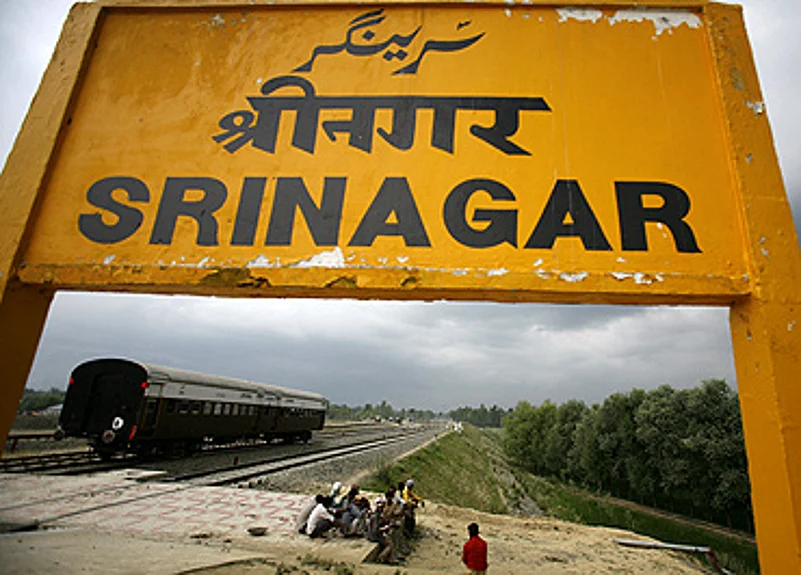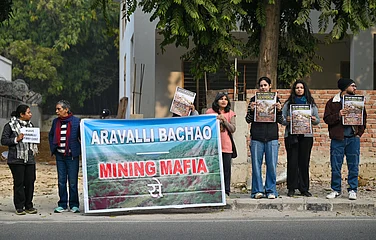- The Kashmir Valley's first-ever railway line, a 60-km stretch from Budgam to Anantnag, is ready, and will probably carry its first passengers in end-June
- The nine stations on this line include Pampore, Awantipora, Srinagar and Baramulla
- The Srinagar station is a dazzling showcase for Kashmiri art, with carved wood panelling, chandeliers and landscaped gardens
- The engines, bogies were brought up to the valley by road on special trolleys
- Heavy security cover is in place along the entire track as well as on the train
- Another 60-km stretch in the valley, from Baramulla to Qazigund is, meanwhile, nearing completion
- The final 200 km, from Qazigund to Katra in the Jammu region, presents a formidable engineering challenge, with much of the track to be laid in tunnels bored through mountains
***

Lone link: A bogie past Srinagar station
Welcome to Kashmir's newest passion. Forget the militants, forget the violence, forget even 'azaadi' for a brief moment. Come evening, and all roads lead to wherever the bogies of Kashmir's first-ever railway train are parked for the day.
The first phase of the Katra-Udhampur-Baramullah all-weather railway line, meant to end Kashmir Valley's isolation from the rest of the country—it is also the nation's most ambitious railway project after Independence—is ready to roll. Although this phase does not as yet link the valley to Jammu, because the construction of the track in the hill section will take a few more years, a 120-km stretch within the valley, from Qazigund to Baramulla, will soon give Kashmiris their first experience of rail travel.
Many Kashmiris have never seen a railway train, let alone travelled in one. After years of seeing very little development in the area due to militancy, the railway line is the most exciting thing to have happened to them in a long time. Small wonder then that when trial runs for the 60-km Budgam-Anantnag section began in February this year, huge crowds turned out not just to witness this novel sight, but also to get a joyride on the train. So much so that the police had to be called in to restrain the crowds. The measure of Kashmiri enthusiasm in the rail can be gauged from college students Aziz and Rafique Ahmed are two who take visible pride in the train and railway infrastructure coming up near their home in Budgam. "We told the railway authorities that since the railway is being built on our land, they should at least give us a ride. Happily for us, they obliged, and virtually our whole village clambered aboard the train that day," says Aziz. Kids at the Srinagar railway station had a similar experience when Union railway minister Laloo Prasad Yadav came visiting last month. When the bogies and railway engines were brought into the valley for the first time—carried up by road last March on specially built trolleys through the Jawahar Tunnel—it created a sensation.
The Kashmir railway project is novel for outsiders too. The newly built Srinagar railway station is drawing not only people from surrounding villages but also visiting tourists. The stunning three-storeyed railway station building, a far cry from the squalor and chaos of most stations in the plains, boasts beautifully carved wooden panelling and chandeliers, and is surrounded by landscaped gardens. "Our attempt has been to replicate the local architecture in all the 15 railway stations which fall within the valley," Bhuvnesh Khare, chief administrative officer, Northern Railways, told Outlook. "The Srinagar station is particularly prestigious and we wanted it to display local artisanship at its best, so. Kashmiri craftsmen have created the wood panelling here." In fact, the railways and their contract agency ircon International Ltd have the explicit mandate to ensure that all contracts for construction works in the 120-km valley section are given exclusively to Kashmiris. Says a railway official: "We cannot even consider contractors from Jammu because the idea is that the money for constructing the railway project should go to Kashmiris from the valley. We want them to feel a sense of ownership."
It's too early to say whether the railway will help end the decades-old sense of alienation which many Kashmiris nurse. It's also premature to predict if it will help end the violent militant activity. But what is already clear is that ordinary Kashmiris are so enthusiastic, even possessive, about the railway line that despite several attempts to sabotage the project (see box) in the last two years, militants have refrained from attacking it directly for fear of angering the local population. Railway officials in charge of ensuring its security say that although elaborate security systems for the tracks and the train have been put in place, the most effective shield are local sentiments and pride.
Commercial operations on the first 60-km section from Budgam to Anantnag will commence shortly. It has nine railway stations—at Anantnag, Baijpora, Pampore, Kakapora, Awantipora, Rajvoser, Srinagar, Budgam and Baramulla. But the construction of the crucial 200-odd kilometres from Qazigund to Katra in the Jammu region, which comprises the difficult hill section, is still mired in technical and geographical hurdles. Officials say the project was initially rushed through without a comprehensive geological survey. Result: many tunnels have collapsed during construction as the rail alignment is along a geological faultline. Around 41 per cent of this track will be through tunnels which will pass through inaccessible mountainous terrain, including the longest 11-km tunnel at Banihal Pass. This phase is expected to take much longer to complete than the original 2012 deadline. However, with commercial operations scheduled to begin in the valley section very soon, most Kashmiris are waiting with mounting excitement to make this first, historic train journey in the valley.


























